
Pembroke Dock at War - General


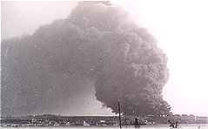
In 1940 German airmen, speeding low over
Sycamore Street, waved down to the young Mrs
Joan Davey and Jean Parkinson.
Not suspecting an enemy
plane, the two girls waved
back. Seconds later ........
.. the JU88's bombs ignited Pennar oil
tanks (seen from Neyland, silhouetted
to the right of the huge smoke plume).
From the Crimean war to World War II and after, townspeople welcomed the servicemen and families based in Pembroke Dock. War had a marked effect on
life in the town, with its substantial garrison. Before 1926 Pembroke Dock also housed a Royal Naval dockyard and, after 1930, a Royal Air Force base.
(Sources: Scott, In harm's way 32) Pictures by courtesy of: JU88, HMSO - Oil tanks ablaze, ex-Chief Inspector Winston Jones & Pembrokeshire Record Office.

Pembroke Dock at War - Victorian times to 1914
During the Crimean War (1854-6), shipwrights worked long hours to complete vessels needed urgently
for operations the Black Sea and the Baltic. Earlier Pembroke Dock-built ships were already on
station. The gigantic HMS Duke of Wellington, for example, was Admiral Napier's Baltic flagship. Small
boats from HMS Vulture attacked the Finnish harbour of Kokkola - one is still preserved there.
The embarkation of the 31st Regiment for the Crimea morning was, for townspeople, "impressive and
memorable". Mrs Peters describes the scene: "The ground on that (February ) morning was covered
with a sprinkling of snow, and the air was bitterly cold and cheerless. The soldiers marched from the
Hill to the Dockyard steps amidst much excitement and many tokens of grief from wives, families and
friends who accompanied them in order to bid them farewell". . Local poet Samuel Cozens described
the soldiers embarking on their on their troopship:
"It is thus with the soldiers as they march to the shore
To embark in the beautiful ship, Imperadore;
Safe she rides at her moorings in beauty and pride,
And her steam curls aloft as she swings with the tide ..."
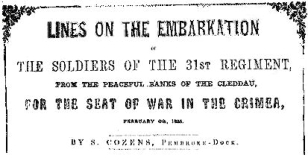
Title of ballad sold "for the benefit of the wives
and families of the above regiment".
Later in the nineteenth century, townspeople hailed soldiers from other units. The South Wales Borderers included the unit remembered for its heroism at Rorke's
Drift, where a small British force had held off an attacking Zulu army. In 1895, after being feted in Pembroke Castle, the SWB marched into Pembroke Dock
accompanied by a band, "preceded by the Mayor and Corporation ... The streets were thronged with people, and the town was decorated for the occasion". In
1899, the 1st Battalion Royal Welsh Fusiliers left Pembroke Dock for the Boer war.
(Sources: Carradice 48; Peters 35, 72-3, 77-78; Scott, Pembrokeshire soldiery 350-1, Shall I on the battlefield ...)
Picture by courtesy of Pembroke Dock Museum Trust (photo.: Mrs Gwen Griffiths).

In World War 1, complaints came from elsewhere in the county that Dockyard workers led an easy life. Already doing war work, they could not be made to serve in
the army.
This memorial in Pembroke Town Hall tells a different story, commemorating the four hundred Dockyard men who joined up. Many won medals, and twenty four
lost their lives.
The pictureto the left shows some fine carved details. Behind the clock tower building (later destroyed by fire) ships' bows may be seen.
World War I may have prolonged the Dockyard's life, with repair work, and orders for light cruisers, submarines and small ships. Dockyard workers would remember
building the cruisers now being lost at war, some with local men aboard. HMS Amphion was mined, HMS Nottingham was torpedoed. HMS Warrior and HMS Defence
were sunk at the Battle of Jutland. The United States Coastguard cutter Tampa, based in Pembroke Dock, was sunk with all hands.
Up to four thousand soldiers were stationed in the town. Cllr William Smith and his friends ensured they were made welcome, and entertained with concerts in the
Market House. He recalls drilling with the home defence volunteers, whose efforts tried their officer's patience to the limit: "We marched and countermarched ...
our wheeling into line was not perfect. At times, Captain McIntosh was almost frantic. He did not, however, use profane language. He was a chapel deacon".
In When the poppies bloom again, Vernon Scott paints a vivid picture of everyday life in Pembroke Dock during World War I. Patriotic recruiting meetings failed to
produce enough volunteers. Conscription followed. From elsewhere in the county came complaints of Dockyard workers avoiding the call-up. Food shortages
became an underlying problem. Letters from abroad brought relief that loved ones were still safe, or grief when they carried sadder news. Rallies were organised
in Albion Square. Concerts and the cinema provided entertainment.
Some of this is seen through the eyes of Millie Dony, a bright young lady who kept a diary. When peace is declared, Millie describes the hooters, bells, guns, flags,
bands, cheering crowds. The servicemen could finally unwind, in true Pembrokeshire style - "the soldiers and sailors were acting as if they had gone dull. They
were like it the whole day !"
(Sources: Phillips, Pembroke Dockyard 170; Carradice 92; Smith, Autobiography; Scott, When poppies bloom...)
Pictures by courtesy of Pembroke Town Council (photos by Mrs Gwen Griffiths).
Pembroke Dock at War -
World War 1

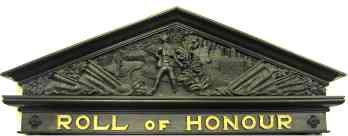

Until 1939, war mostly happened away from Pembroke Dock. In World War II, the town itself was in the front line. The RAF flying boats were only hours from
action against enemy submarines and aircraft. Pembroke Dock, with its air station, barracks and naval oil depot, was within easy range of German bombers
based in France - a vulnerable target, suffering repeated air raids.
On 19 August 1940 three Junkers 88s, in broad daylight, set an oil tank alight at the Llanreath Admiralty depot. Vernon Scott describes the immediate chaos
nearby: "Shrieking mothers, some hysterical, were frantically looking for children" and terrified pigs fled squealing down Military Road. Firemen, soon on the
scene, found "jet black smoke churning across the carriageway in such dense clouds it was impossible to see ... The blaze was creating a deafening roaring
noise". Arthur Morris and the other fire fighters had to "shield their faces from the scorching heat".
For the next fortnight the huge column of smoke, "a sombre and awe-inspiring spectacle", was visible from a hundred miles around. The spreading blaze
destroyed 11 of the 17 oil tanks. Brigades from across the country quickly joined local fire fighters - a final total of around 650 men. Many were injured, and
were tended nearby. Five Cardiff firemen lost their lives when a collapsing tank erupted.
Night attacks on Pembroke Dock began in 1940 and continued in 1941. Witnesses recall the sound of sirens, plane engines, anti aircraft guns, and
different types of bomb. Some screamed down. Batches of incendiaries clattered as they hit the ground. Fabric rustled above parachute-borne mines.
Other survivors recall the pervasive smells of burning, and of damp earth churned up by the explosions.
In one attack alone (May 12 1941), 32 people died and 2000 houses were damaged.
Mr Bill Richards, then a reporter, paints two vivid pictures of these raids. By May 1941 many people had taken to fleeing the town at night - "an
unforgettable scene was witnessed at Mill Bridge, Pembroke. Down the hill from Pembroke Dock they came in an endless stream, in cars, lorries and
overloaded buses, on motorcycles, bicycles and horse drawn carts. Hundreds came on foot, weary mothers with infants in arms and little boys and girls of
hardly school age running behind ... old men on sticks ... subdued boys and frightened girls. Nearly very person clutched tightly some valued possession.
Many of the vehicles were piled high ... Dogs, cats, caged birds and parrots accompanied their owners... long after the stars had studded the sky there
were stragglers hurrying from the devastated town"
On June 11 German pathfinders, navigating by radio beams, marked their target with firebombs. The main force of Heinkel bombers followed up with
more incendiaries, and high explosive bombs. This raid, "watched from Pembroke, ... was an awesome spectacle. Fire appeared completely to envelop
the town, and through it dark clouds of smoke billowed and played. Every few moments there would be a bright flash against the red glow as the bombs
exploded. The darkness above was broken by the golden, rippling stars of anti aircraft fire ... the whole scene was a confusion of darkness and light and
noise, awesome and well nigh overwhelming".
Firemen, first aid crews, air raid wardens, civil defence workers, and policemen would stay at work in this murderous chaos.
One air-raid tale concerns policemen Jack Evans and Joe Gough, who place an unexploded bomb in their car, drive carefully to Hobbs Point pier and drop
the bomb over the side. It exploded with a fountain of spray, as it hit the water. This courageous act, the story goes, earned them a stiff reprimand: they
had without authority endangered two pieces of police property - a) the car and b) themselves.
(Sources: Richards 1983 66, 70, 72, 85 ; Carradice 96; Scott, In harm's way 35 41 52 85 , Pioneer pathfinders, Great fire raid )
Pictures by courtesy of: Firemen, Mr John Arter - Parade after air raid, Pembroke Dock Museum Trust.
Pembroke Dock at War - World War II
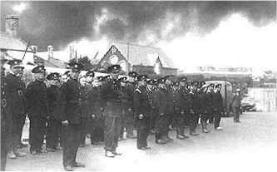
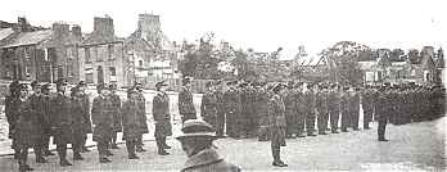
Treowen Road, August 1940. Tired firemen at roll call
by Pennar School. Behind them, acrid smoke pours from
the burning oil tanks.
Order after chaos: Parade before the wreckage of Market Street, 1941.

Sgt. A. W. Allen Army
Lt. Q.M. W. L. Ambrose Essex Regiment
Sgt. Pilot. J. H. Bevans R.A.F.
Bdr. B. Beasant Royal Artillery
Pte. K. L. Bittle Royal Marine Engineers
Pte. R. F. Bittle R.A.O.C.
Capt. Q.M. W. Cooper Welch Regiment
Pte. M .C. Clapton Airborne Forces
Pte. E. R. Darlington 2nd. Battalion Yorks
Sgt. D. J. Davies Signals
Sgt. E. Davies Army
Pte. T. A. Dilworth 2nd. Buffs
Lance Sgt. E. C. Donohoe Kings Shropshire Light Infantry
Sapper E. C. Edwards Royal Engineers
W. G. Evans Royal Artillery
W. R. J. Forward H.M.S. Glorious
Sgt. E. George Royal Engineers
Pilot Officer T. J. Hordley R.A.F.
Staff Sgt. C. Isaacs R.E.M.E
Chief P.O. A. L. James H.M.S. Gloucester
Sgt. R. James Royal Tank Regiment
Warrant Officer F. E. Johnson R.A.F.
Lieut. C. Kelly Royal Artillery
Sgt. E. G. Lewis R.A.F.
Lance Bombadier G. Lewis Royal Artillery
Trooper A. S. Makin 1st. Tank Regiment
Lieut. G. J. Mathias Royal Navy
Sgt. Engineer J. McKenzie R.A.A.F.
P. McGrath R.A.F.
Gunner A. J. Morris Royal Artillery
Sgt. Pilot J. Mumford R.A.F.
N. Owens R.A.F.
J. Phillips Welch Guards
W. A. Phillips Royal Navy
Sapper J. S. Power Royal Engineers
Pte. R. G. Powell Dorsetshire Regiment
Sgt. Pilot A. Pricket R.A.F.
Chief E.R.A. S. J. Pricket H.M.S. Liverpool
Sgt. M. Rees R.A.F.
Lieut. P. Saunders Army
Sq. Leader Reg. H. Thomas R.A.F.
Sgt. F. Waite Canadian Tank Corp.
Pilot Officer E. Williams R.A.F.
Merchant Navy
T. H. Hogg
1st Officer J. Calnon
2nd Engineer W.C. Hare
Trawlermen
Third hand Engineer D. Evans
Fireman J. Evans
Pembroke Dock at War - Pembroke Dock roll of honour 1939 - 1945
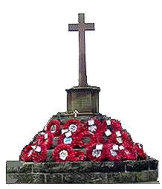
They shall grow not old, as we that are left grow old,
Age shall not weary them, nor the years condemn.
At the going down of the sun and in the morning
We will remember them.
- Laurence Binyon
Servicemen killed in Action.
Servicemen Missing - Presumed Dead
Sgt. C.W. Brinn Army
Stoker D. Broad H.M.S. Exeter
Gunner C. G. Brighty Royal Artillery
Sgt. Observer C. Catherall R.A.F.
Pte. J. Cole Kings Own Rifles
Gunner F. Dean Royal Artillery
Ronald Davies H.M.S. Hood
L/Corp. C. W. F. Darbon R.A.O.C.
Sgt. N. Earnshaw R.A.F.
Petty Officer G. Gibby Royal Navy
Pte. J. Griffiths Army
Pte. N. H. Griffiths Royal Artillery
A. B. D. Grifiths
Pembroke Dock Air Raid Victims
S. H Buxton Home Guard
J. A. Bowen 41 Laws Street
Mrs. A. R. Brazel 6 Gwyther Street
Miss K. Brazel 6 Gwyther Street
J. T. Baskerville 91 High Street
Dorothy Dunn 4 Gwyther Street
Corporal Dunn 4 Gwyther Street
Agnes G. D. Evans 37 Laws Street
Mrs. M. E. T. Evans Prince Albert Inn
Thomas Evans 37 Laws Street
Mrs. H. M. B. Hammerton 35 Laws Street
Mrs E. J. Harries 35 Laws Street
J. F. Harries 35 Laws Street
Mrs. Maude Harvey 16 Bush Street
Mrs. D. Hearn 6 Gwyther Street
Mrs. C. E. Heath 3 Melville Street
Maurice Heath 3 Melville Street
Mrs. E. Hutchings 33 Laws Street
Cyril M. Jenkins Imble Lane 1941
Arthur J. Kavangh (A. R. P.) Imble Lane 1941
Mrs. C. E. Kinton 14 Bush Street
W. H. Kinton 14 Bush Street
David M. Lenham (18 months) 4 Gwyther Street
Mrs. E. M. Lenham 4 Gwyther Street
Alexandra McKenzie 31 Laws Street
Cyril McKenzie 31 Laws Street
Mrs. L. E. McKenzie 31 Laws Street
Rhys Morris Pier Hotel
Miss E. Morris Pier Hotel
Thomas Phillips Prince Albert Inn
Walter S. Pounder Gwyther Street
Harry H. R. Reynolds 39 Laws Street
Mrs. Elizabeth Reynolds 39 Laws Street
Henry Roach Prince Albert Inn
Mrs. A. B. Robinson 4 Melville Street
Mrs. E. F. Saunders 4 Tremeyick Street
J. H. Thomas 31 Lewis Street
Elizabeth Williams Pier Hotel
Matilda Williams 91 Military Road
Air Raid Victims Killed Elsewhere
Mrs. M. James 26 Prospect Place (London)
C. F. Owen 43 Park Street (Gosport)
Mrs. Oakes Lewis Street (London)
Sidney Peters 17 Brewery Street (Plymouth)
Mrs.Sidney Peters 17 Brewery Street (Plymouth)
This Roll of Honour, published by Pembroke Dock Town Council, was prepared by Councillor D. L. Jones with the help of Mr. Tom Davies and Mr. Roy Hordley.
Councillor Jones also wishes to acknowledge the help he has received from many other persons in checking, reviewing and typing the information. Some entries
may be inaccurate and there may be some omissions but it is hoped that these will be corrected in the course of time as more information is received.

Pembroke Dock at War - Celebrations & memorials
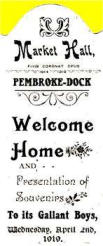
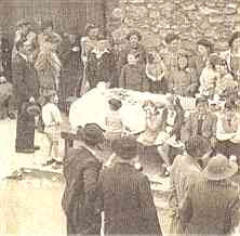
In 1919 (left), the town welcomes back its sons. In 1945 (right)
street parties greet peace. Here, adults and children celebrate
in Gwyther Street
Memorials
Today, the Memorial Park commemorates servicemen who fell in World War I.
The park gate is a memorial to the victims of Second World War air raids,
including Arthur Kavanagh and Cyril Jenkins, two teenage volunteer
messengers. The town's war memorial honours the dead of these and other
wars. South Pembrokeshire Golf Club, by the site of the now demolished oil
tanks, has a tablet dedicated to the firemen of 1940. Arthur Morris, the
town's chief fire officer, tirelessly directed operations at the oil tanks until
help arrived. He received little acknowledgement at the time, but "Arthur
Morris Drive" is now named in his memory.

Pictures by courtesy of: 1919 programme, Mr & Mrs A. Lloyd - Street party, Mr R. Ridley - Arthur Morris Drive, Mr M. Blake

TOP
HOME
Collections were later made for wives and families, and for the soldiers themselves. News from the Crimea would be read to anxious crowds gathered at the
Clarence Hotel, near the foot of the Barrack Hill.
(Amendment, updates and additions) (AJ) Anndra Johnstone
This site is designed, published and hosted by CatsWebCom Community Services © 2018 part of Pembroke Dock Web Project


































